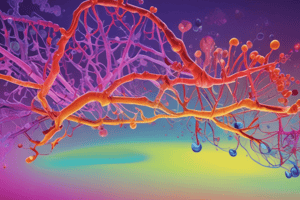Podcast
Questions and Answers
Which type of molecular substances are expected to exhibit fluorescence?
Which type of molecular substances are expected to exhibit fluorescence?
- Saturated aliphatic compounds
- Heterocyclic rings without conjugated double bonds
- Aromatic or multiple conjugated double bonds (correct)
- Molecules with electron withdrawing groups
What type of substitution groups often enhance fluorescence?
What type of substitution groups often enhance fluorescence?
- -NO2 and -COOH groups
- -NH2, -OH, -OCH3, -NHCH3, and -N(CH3)2 groups (correct)
- -NH3+ and -COOH groups
- -NH2 and -NO2 groups
Which factor favors fluorescence in molecules?
Which factor favors fluorescence in molecules?
- Flexible structures
- Rigid structures (correct)
- Lack of conjugated double bonds
- Presence of saturated aliphatic chains
In which type of rings is fluorescence expected unless they are fused to benzene rings?
In which type of rings is fluorescence expected unless they are fused to benzene rings?
How does the formation of chelates with metal ions affect fluorescence?
How does the formation of chelates with metal ions affect fluorescence?
Which type of rings are expected to show fluorescence unless they are fused to benzene rings?
Which type of rings are expected to show fluorescence unless they are fused to benzene rings?
What type of substitution groups often enhance fluorescence?
What type of substitution groups often enhance fluorescence?
Which factor favors fluorescence in molecules?
Which factor favors fluorescence in molecules?
What is the effect of electron withdrawing groups on fluorescence?
What is the effect of electron withdrawing groups on fluorescence?
In which type of compounds does the fluorescence increase by increasing the number of aromatic rings?
In which type of compounds does the fluorescence increase by increasing the number of aromatic rings?
Flashcards are hidden until you start studying
Study Notes
Molecular Substances and Fluorescence
- Organic compounds with conjugated double bonds often exhibit fluorescence due to their ability to absorb and emit light.
- Fluorescence is notably present in molecular substances that have extended π-electron systems.
Substitution Groups Enhancing Fluorescence
- Electron-donating substituents, such as alkoxy or amino groups, often enhance fluorescence by stabilizing the excited state.
- Substituents that promote planarity and reduce steric hindrance also contribute positively to fluorescence.
Factors Favoring Fluorescence
- Molecules with a lower energy gap between the ground and excited states favor fluorescence, promoting efficient energy transitions.
- High quantum yield is also a factor that favors fluorescence, indicating a significant probability of light emission.
Rings and Fluorescence
- Non-fused cyclic compounds, like certain heterocycles and polycyclic aromatic hydrocarbons, are expected to exhibit fluorescence unless fused to benzene rings.
Effect of Chelates with Metal Ions
- The formation of chelates with metal ions can significantly quench fluorescence by disrupting the electronic configuration necessary for light emission.
- Chelation often leads to reduced π-electron delocalization, diminishing fluorescence intensity.
Aromatic Rings and Fluorescence
- Aromatic compounds typically show pronounced fluorescence, especially polyaromatic systems, unless they are fused with benzene rings which can affect emission properties.
Electron Withdrawing Groups
- Electron withdrawing groups tend to decrease fluorescence by destabilizing the excited state, resulting in lower emission efficiency.
Effect of Aromatic Rings on Fluorescence
- The fluorescence of compounds often increases with the number of aromatic rings due to enhanced π-stacking and electronic interactions within multi-ring systems.
Studying That Suits You
Use AI to generate personalized quizzes and flashcards to suit your learning preferences.




